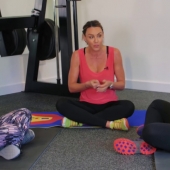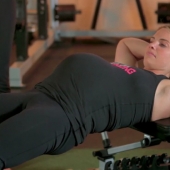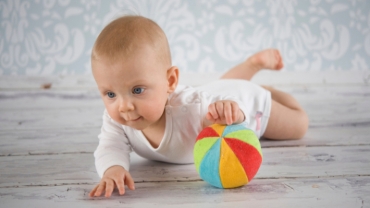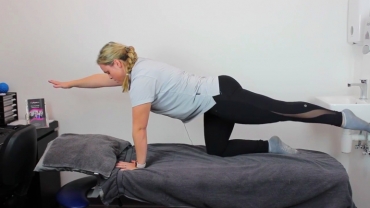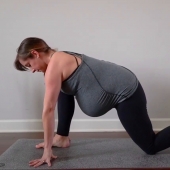We're looking at the key changes that happen to your posture during pregnancy and their effects on your pelvis for birth preparation. So let's look at the key changes in pregnancy first.
Now, as you progress through each trimester, the hormone relaxin calls to your ligaments, which are your joint stabilisers, to soften, as well as the connective tissue, as well. So this means that your joints become less stable.
This, and the weight that you naturally gain during pregnancy, can have a real impact on your posture and the types of niggles and issues that you'll experience both during pregnancy and afterwards, too.
So let's take a look at the centre of gravity and how that changes first. So what we'll find during pregnancy, if left unaddressed, is that the pelvis will tilt forwards, so like so, and then the centre of gravity will shift from over the heels to more over the toes like this.
And then to try and correct yourself, a woman will sort of try and stand a bit more upright, which then you can see is causing excessive curvature of the lower back. This will cause all sorts of back pain issues here and really compress those vertebrae, and compromise the health.
If we look at what's going on above the pelvis, so looking at the shoulders now. As a woman progresses through her pregnancy, her boobs get heavier. You'll often find that we've rounded shoulders here, so we've shortened and tight chest muscles, and then at the back, you've got lengthened but tight upper back muscles too.
Also, to try and correct her posture and appear more upright what you'll find is that a woman will jut her chin out, as well, to sort of try and look like she's standing upright and trying to correct that posture. And this will cause excessive stress and strain on the neck and upper back muscles as well. And then finally, if that wasn't enough, from this sort of position here what you'll then be doing is causing excessive pressure on the linea alba.
The linea alba is the connective tissue which joins the two bellies of the abdominis rectus, that's actually the six-pack muscles, and this extra pressure will cause a natural widening of the linea alba and abdominal separation, as well, which need to be addressed because it's a core weakness. So how do we go about fixing this?
Well, it's a whole body issue that's required. We need to look at stretching and releasing exercises as well as strengthening exercises to address all these issues going on. So we look at releasing the shoulders and also look at the ribs as well, getting those dropped down because one thing that will happen in pregnancy, a lot of the time, is women will flare their ribs up here when, in fact, they need to be more sort of down into here. And this will allow you to maintain the space for the baby to grow but also give you more room to breathe, as well.
So particularly with pregnancy, when the vital organs shift up to accommodate the baby bump, you are looking for the extra space in which to breathe. So this will happen now with the vertebrae lower. We're then getting you stacked up correctly so the pelvis is in the right position and this will help gravity do it's job during childbirth as well.
And then, finally, just strengthening those areas which are weak and this will often be the natural hip muscles, the glutes, as well as the core. Now if you'd like other information about how to help yourself, you can download my free guide: five ways to improve your pelvic health naturally. You should find the link below.
And if you're in Exeter or the Exeter area and if you'd like to join me on the next six-week pelvic floor programme; if you hop over to my website and go to the pelvic floor page, you'll find all the details there. Finally, if you have any questions, please don't hesitate to get in touch, I'd be very happy to help you.
www.thefitmovement.co.uk/fit-pelvic-floor
- 1484 views


